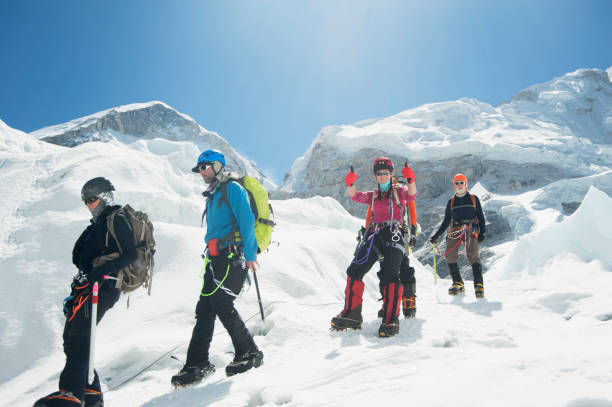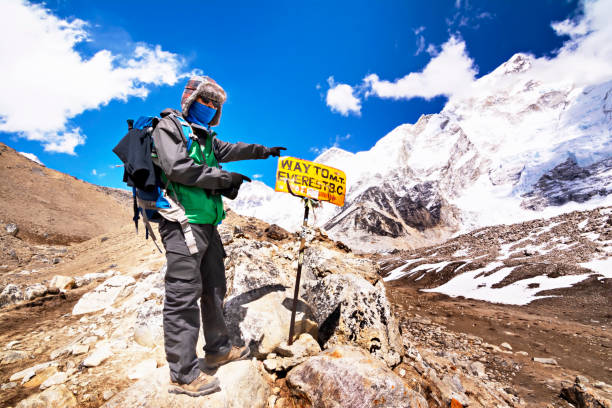Mount Everest for Snowboarding
Snowboarding, an exhilarating sport that blends the thrills of skiing and surfing, has evolved into an extreme sport enjoyed by millions around the world. For the most adventurous, snowboarding on the highest peak on Earth, Mount Everest represents the pinnacle of the sport.
Table of Contents
ToggleThis majestic mountain, standing at 29,032 feet (8,848 meters), presents not just a geographical challenge, but a testament to human endurance and the relentless pursuit of adrenaline.

The Allure of Mount Everest
Mount Everest, part of the Himalayan range in Nepal and Tibet, has captivated explorers for centuries. The allure of its snow-covered peaks, treacherous terrain, and the sheer magnitude of the challenge it presents, attracts mountaineers, skiers, and snowboarders alike. For snowboarders, Everest offers the ultimate test: navigating some of the harshest weather conditions and steepest slopes on Earth.
Location on Map
Mount Everest, the world’s highest mountain, stands at an impressive elevation of 29,032 feet (8,849 meters). It is located in the Great Himalayas of southern Asia, straddling the border between Nepal and the Tibet Autonomous Region of China. The mountain’s precise coordinates are 27°59′ N latitude and 86°56′ E longitude.
This iconic peak is renowned for its towering height and the challenging conditions it presents to climbers, making it a symbol of adventure and human endurance. Everest’s imposing presence and significant geographical location make it a notable landmark in both Nepal and China.
Preparing for the Ascent
Snowboarding on Mount Everest requires meticulous preparation. This begins with physical conditioning. The mountain’s extreme altitude poses significant risks, including altitude sickness, which can be fatal. Snowboarders must engage in rigorous cardiovascular and strength training to ensure they can endure the thin air and physical exertion required to reach the summit.

Moreover, understanding the weather patterns is crucial. Everest’s climate is unpredictable, with sudden snowstorms, avalanches, and temperatures that can plummet to -60 degrees Celsius. Most expeditions target the brief windows of favorable weather in late May and early October.
Acclimatization is another critical component. Climbers spend weeks ascending and descending the mountain to allow their bodies to adjust to the reduced oxygen levels. This process is vital for increasing red blood cell production and ensuring that the body can function at high altitudes.
Gear and Equipment
The right gear can make the difference between life and death on Everest. Snowboarders must invest in high-quality, insulated clothing to protect against the extreme cold. Layering is essential, starting with moisture-wicking base layers, followed by insulating mid-layers, and topped with waterproof, windproof outer layers.
Specialized snowboarding boots designed for mountaineering are necessary, as they provide the required support and warmth. Snowboards must be selected with care, focusing on those that can handle deep powder and icy conditions. Additionally, carrying an ice axe, crampons, and ropes is essential for traversing the glacier and steep, icy sections of the mountain.
The Descent: A Thrilling Ride
Once the summit is reached, the descent on a snowboard is a thrilling, albeit dangerous, endeavor. The Lhotse Face, a steep and icy wall, presents the first significant challenge. Snowboarders must carefully navigate this section, balancing speed with control to avoid falls that could lead to serious injury or death.
Further down, the Western Cwm, also known as the “Valley of Silence,” offers a slightly less steep descent but is no less perilous due to the crevasses that litter the glacier. This section requires precision and the ability to read the terrain accurately to avoid hidden dangers beneath the snow.
The Khumbu Icefall, one of the most dangerous sections of the mountain, requires careful navigation. Snowboarders must thread their way through a maze of towering ice seracs and deep crevasses, often necessitating the use of ropes and ladders installed by Sherpas.
The Risks and Rewards
Snowboarding on Mount Everest is not without significant risks. The high altitude and severe weather conditions can lead to frostbite, hypothermia, and altitude sickness. Avalanches and falling ice are constant threats, and the physical toll on the body is immense.
Despite these dangers, the rewards are equally significant. Successfully descending Everest on a snowboard is a remarkable achievement, showcasing not only one’s physical prowess but also mental fortitude and skill. The breathtaking scenery, from the view of the Himalayas to the pristine, untouched snow, offers a surreal experience that few will ever witness.
Pioneers of Everest Snowboarding
Several pioneers have left their mark on Mount Everest’s snowboarding history. Marco Siffredi, a French snowboarder, was the first to snowboard down Everest in 2001. His descent via the Norton Couloir remains legendary, though tragically, he disappeared during his second attempt in 2002.
Others, like Stephen Koch, an American alpinist, have also made significant contributions, attempting snowboard descents from various points on the mountain. These pioneers have inspired a new generation of extreme sports enthusiasts to push the boundaries of what is possible on the world’s highest peak.
Environmental and Ethical Considerations
Snowboarding on Mount Everest also brings to light important environmental and ethical considerations. The mountain faces significant challenges from the impact of increased tourism, including litter and environmental degradation. Responsible snowboarding involves adhering to the Leave No Trace principles, ensuring that all waste is carried out, and minimizing the impact on the fragile alpine environment.
Furthermore, respecting the local culture and the Sherpa community, who play a crucial role in supporting expeditions, is paramount. Acknowledging their contributions and ensuring fair compensation is an ethical obligation for all adventurers.
Conclusion
Mount Everest, with its daunting height and harsh conditions, stands as the ultimate challenge for snowboarders. The journey to the summit and the exhilarating descent demand peak physical fitness, exceptional skill, and unwavering determination. For those who dare to undertake this adventure, the rewards are unparalleled—a testament to human endurance and the unyielding spirit of exploration.
Click to read about Marco Siffredi – A French snowboarder who disappeared at Mount Everest.
In the pursuit of conquering the highest peak on a snowboard, adventurers must also embrace their responsibility towards preserving the environment and respecting the local communities. Snowboarding on Mount Everest is not just a personal triumph but a collective journey that connects us to the grandeur of nature and the enduring legacy of human courage.
FAQ’s
In which country is Mount Everest?
Mount Everest is located on the border between two countries: Nepal and China (specifically, the Tibet Autonomous Region of China). The southern side of the mountain lies in Nepal, while the northern side is in Tibet, an autonomous region of China. This unique positioning makes Mount Everest accessible from both countries.
How many climbers have died on Everest?
Since the early 1920s, more than 330 climbers have died on Mount Everest. Of these, approximately 200 bodies remain on the mountain, serving as somber reminders of the mountain’s dangers. One of the most well-known bodies is that of “Green Boots,” a climber whose brightly colored footwear marks a tragic landmark. These grim statistics highlight the perilous nature of Everest, and maps of the area provide surprising insights into its morbid geography, pinpointing the locations of various fatalities and the extreme risks involved in attempting to reach the summit.
Who climbed Mount Everest first?
The first successful ascent of Mount Everest was made by Sir Edmund Hillary of New Zealand and Tenzing Norgay, a Sherpa of Nepal, on May 29, 1953. Their achievement marked a significant milestone in mountaineering history, as they became the first climbers to reach the summit of the world’s highest peak. This historic climb was part of a British expedition led by Colonel John Hunt.
What is the biggest killer on Everest?
The biggest killer on Mount Everest is acute mountain sickness (AMS), also known as altitude sickness. This condition occurs due to the low oxygen levels at high altitudes, causing symptoms such as headaches, nausea, dizziness, and, in severe cases, fluid buildup in the lungs and brain, which can be fatal. Other common causes of death on Everest include falls, avalanches, exhaustion, crevasses, exposure, and hypothermia. Each of these hazards poses significant risks, making the ascent to Everest’s summit a perilous endeavor.
Who is Sleeping Beauty on Everest?
“Sleeping Beauty” on Mount Everest refers to Francys Arsentiev, an American climber who tragically died during her expedition in 1998. Francys, along with her husband Sergei Arsentiev, attempted to reach the summit without supplemental oxygen. Although she achieved her dream of summiting Everest, she encountered difficulties during the descent and succumbed to the harsh conditions of the mountain.
Her body, which remained on Everest for years, became a poignant symbol of the mountain’s dangers and the ultimate price some pay in pursuit of their dreams. Francys Arsentiev’s story is both tragic and inspirational, reflecting the intense challenges faced by climbers on Everest.
How many attempts to climb Everest?
Around 800 people attempt to summit Mount Everest each year. However, the mountain’s allure extends beyond just those trying to reach the peak. Approximately 100,000 people visit the Sagarmatha National Park annually, which encompasses Everest. Additionally, about 500 people make the trek to Everest Base Camp each day, showcasing the mountain’s enduring appeal to adventurers and tourists alike.






